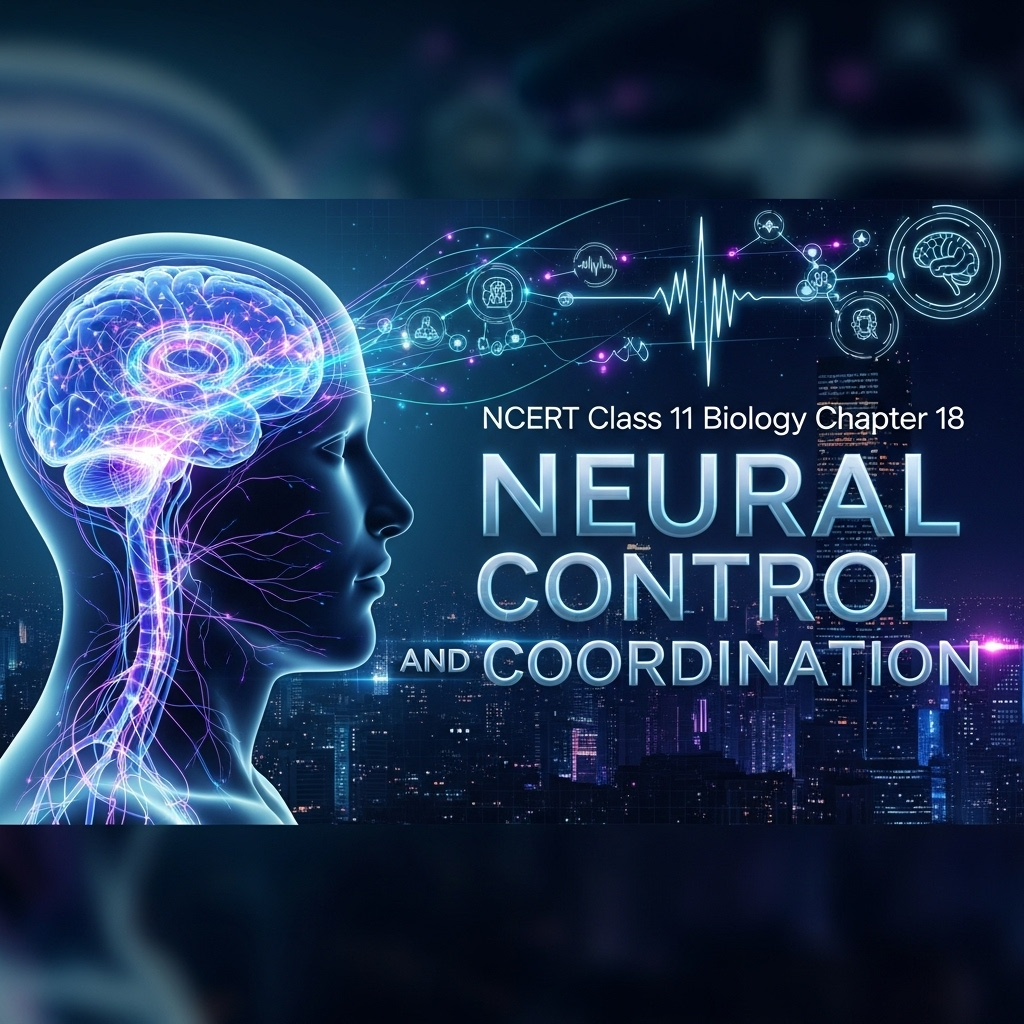Complete Solutions and Summary of Neural Control and Coordination – NCERT Class 11, Biology, Chapter 18 – Summary, Questions, Answers, Extra Questions
Summary of nervous system structure, neuron function, reflex action, brain regions, and coordination mechanisms along with NCERT exercises.
Updated: 2 months ago
Categories: NCERT, Class XI, Biology, Summary, Nervous System, Neural Control, Brain, Neurons, Reflex Arc, Chapter 18

Neural Control and Coordination
Chapter 18: Biology - Ultimate Study Guide | NCERT Class 11 Notes, Questions, Examples & Quiz 2025
Full Chapter Summary & Detailed Notes - Neural Control and Coordination Class 11 NCERT
Overview & Key Concepts
- Chapter Goal: Understand how the neural and endocrine systems coordinate body functions for homeostasis. Exam Focus: Neuron structure, nerve impulse generation/conduction, synapses, brain parts. 2025 Updates: Emphasis on neural disorders and synaptic plasticity. Fun Fact: The human brain has about 86 billion neurons, forming trillions of synapses. Core Idea: Neural system provides rapid point-to-point communication via electrical impulses. Real-World: Applications in neurology, treating conditions like Alzheimer's or epilepsy.
- Wider Scope: Links to physiology, endocrinology, and neuroscience; foundational for understanding behavior and diseases.
Introduction: Coordination and Homeostasis
- The body maintains homeostasis through coordination between organs. During physical exercise, energy demand rises, increasing oxygen supply, respiration rate, heartbeat, and blood flow. Post-exercise, systems return to normal via neural and endocrine integration.
- Neural system: Organized network for quick point-to-point coordination. Endocrine system: Chemical integration via hormones. Both ensure synchronized organ function.
- Chapter covers human neural system, neuron as unit, impulse transmission, and central neural system (CNS).
- Importance: Ensures survival by responding to stimuli; disruptions lead to disorders like paralysis or sensory loss.
18.1 Neural System
- Composed of specialized cells called neurons that detect, receive, and transmit stimuli.
- Evolution: Simple in lower invertebrates (e.g., Hydra: neuron network). More organized in insects (brain + ganglia). Vertebrates have highly developed systems.
- Neurons form the basic unit, enabling sensory-motor responses.
- Key Point: Neural organization increases with complexity, from diffuse networks to centralized brains.
18.2 Human Neural System
- Divided into CNS (brain + spinal cord: information processing/control) and PNS (nerves linking CNS to body).
- PNS Nerve Fibers: Afferent (sensory: tissue to CNS), Efferent (motor: CNS to tissues).
- PNS Divisions: Somatic (voluntary: CNS to skeletal muscles), Autonomic (involuntary: CNS to smooth muscles/viscera; further sympathetic and parasympathetic).
- Visceral Nervous System: Part of PNS handling viscera impulses.
- Key Point: Afferent/efferent ensure bidirectional communication; autonomic maintains involuntary functions like heartbeat.
18.3 Neuron as Structural and Functional Unit
- Microscopic structure: Cell body (cytoplasm, organelles, Nissl's granules), Dendrites (short, branched, transmit to cell body), Axon (long fiber, ends in synaptic knobs with vesicles/neurotransmitters).
- Neuron Types: Multipolar (one axon, multiple dendrites: cerebral cortex), Bipolar (one axon, one dendrite: retina), Unipolar (one axon: embryonic stage).
- Axon Types: Myelinated (Schwann cells form myelin sheath, nodes of Ranvier: spinal/cranial nerves, faster conduction), Non-myelinated (no sheath: autonomic/somatic, slower).
- Key Point: Nissl's granules aid protein synthesis; myelin insulates for saltatory conduction.
18.3.1 Generation and Conduction of Nerve Impulse
- Neurons excitable due to polarized membrane: Resting potential (-70mV) from ion gradients (high K+ inside, high Na+ outside) maintained by Na+-K+ pump (3 Na+ out, 2 K+ in).
- Stimulus at site A: Na+ influx depolarizes (action potential: +40mV), reverses polarity. Current flows to site B, generating impulse there.
- Repolarization: K+ efflux restores resting potential. Short-lived Na+ permeability followed by K+.
- Conduction: Wave of depolarization/repolarization along axon; faster in myelinated via nodes of Ranvier.
- Key Point: Action potential is all-or-none; threshold stimulus triggers it.
18.3.2 Transmission of Impulses
- Synapses: Junctions between neurons (pre- and post-synaptic). Electrical (close membranes, direct current: fast, rare). Chemical (synaptic cleft, neurotransmitters: common).
- Chemical Synapse: Impulse arrives at axon terminal, vesicles release neurotransmitters (e.g., acetylcholine) into cleft. Bind receptors on post-synaptic membrane, open ion channels, generate excitatory/inhibitory potential.
- Key Point: Neurotransmitters enable one-way transmission; can be modulated for learning/memory.
18.4 Central Neural System
- Brain: Command center for voluntary/involuntary functions, senses, emotions. Protected by skull, meninges (dura mater, arachnoid, pia mater), CSF.
- Parts: Forebrain (cerebrum, thalamus, hypothalamus), Midbrain, Hindbrain (pons, cerebellum, medulla).
18.4.1 Forebrain
- Cerebrum: Largest, two hemispheres (corpus callosum connects), cerebral cortex (grey matter: motor/sensory/association areas), white matter (myelinated fibers).
- Thalamus: Sensory/motor relay. Hypothalamus: Thermoregulation, hunger/thirst, hormone secretion.
- Limbic System: Amygdala, hippocampus; regulates emotions, motivation, sexual behavior.
- Key Point: Association areas handle complex cognition like memory, language.
18.4.2 Midbrain
- Between fore/hindbrain; cerebral aqueduct. Corpora quadrigemina: Visual/auditory reflexes.
- Key Point: Integrates sensory inputs for reflexes.
18.4.3 Hindbrain
- Pons: Fiber tracts interconnecting brain regions.
- Cerebellum: Convoluted; balance, coordination, posture.
- Medulla Oblongata: Respiration, cardiovascular reflexes, gastric secretions; connects to spinal cord.
- Brain Stem: Midbrain + pons + medulla; vital functions.
- Key Point: Hindbrain essential for survival reflexes.
Summary
- Neural system integrates via neurons, impulses, synapses. Human: CNS/PNS. Brain: Fore/mid/hind. Impulse: Polarization/depolarization.
- Applications: Understanding neural diseases, AI-inspired neural networks.
Why This Guide Stands Out
Complete coverage: All subtopics, diagrams explained, Q&A aligned to NCERT exercises. Exam-ready for 2025 with mnemonics and quizzes. Free & ad-free.
Key Themes & Tips
- Coordination: Neural for speed, endocrine for duration.
- Impulse: Electrochemical process.
- Tip: Draw neuron/brain diagrams; memorize ion roles in potential.
Exam Case Studies
Questions on impulse conduction, brain parts functions; compare resting/action potential.
Project & Group Ideas
- Model neuron with wires/batteries; discuss neural disorders like Parkinson's.

Group Discussions
No forum posts available.


